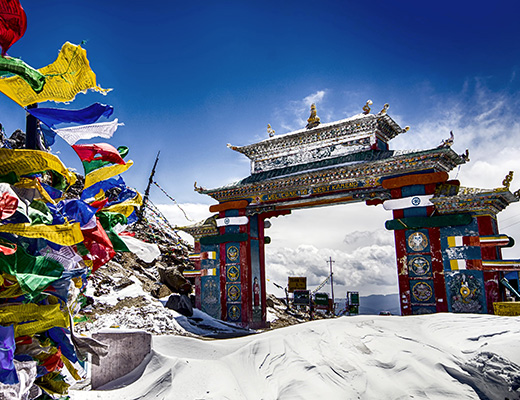Arunachal Pradesh
Arunachal Pradesh has an area of 83,743 sq km, and is the largest state in the Northeast of India that offers diverse topography opportunities for non-timber based industries such as bamboo, cane and medicinal plants.


Introduction

Arunachal Pradesh is the largest among the seven states located in the northeast of India, with an area of 83,743 sq kms. It shares its borders with the neighboring countries of Bhutan in the west, China (Tibet) in the north and northeast, Myanmar in the east and southeast, and the Indian states of Assam and Nagaland in the south. The geographic location of the state provides immense opportunities for international trade with South Asian countries such as Myanmar, Bhutan, and China. At current prices, Arunachal Pradesh’s GSDP is estimated to reach Rs. 34,270 crore (US$ 3.98 billion) in FY25. The GSDP increased at a CAGR of 7.1% between FY16 to FY25.
The state’s per capita GSDP was Rs. 2,80,380 (US$ 3,273.2) in FY24. The per capita GSDP increased at a CAGR of 10.3% between FY16 to FY24.
The land is mostly mountainous with Himalayan ranges. The state is divided into five river valleys - the Kameng, the Subansiri, the Siang, the Lohit, and the Tirap. These river valleys have immense hydropower potential, currently estimated at 50,328 Megawatt (MW), or approximately 22% of India's current power generating capacity.
As of March 2025, Arunachal Pradesh had a total installed power-generation capacity of 783.88 MW. The state has significantly scaled up its capacity by capitalizing on its hydropower potential. The state has significantly scaled up its capacity by capitalising on its hydropower potential. The state's economy is largely agrarian, based on the terraced farming of rice and the cultivation of crops such as maize, millet, wheat, pulses, sugarcane, ginger, oilseeds, cereals, potato, and pineapple. In 2021-22* total horticulture production reached 205.34 thousand metric tonnes (MT).
Some of the other key industries of the state include art and crafts, weaving, cane and bamboo, horticulture, power, and mineral based industry. The state and central Governments have both offered huge fiscal and policy incentives for the development of thrust sectors in the state. Some of these policies include Public Private Partnership Policy 2011, the State Industrial Policy 2008, and the Hydro Power Policy 2008.
Recent Developments in Key Sectors
- According to the Department for Promotion of Industry and Internal Trade (DPIIT), state attracted FDI inflow worth Rs. 60 crore (US$ 7.03 million) between October 2019-December 2024.
- Merchandise exports from the state reached Rs. 15 crore (US$ 1.80 million) in FY25 (until February 2025). Engineering goods, tobacco & spices and gems and jewellery were the most exported items from the state.
- According to the Telecom Regulatory Authority of India (TRAI), Arunachal Pradesh had 12.44 million wireless subscribers and 0.30 million wireline subscribers as of December 2024.
- Arunachal Pradesh had a total tele-density of 79.62%, as of December 2024.
- In the State Budget FY25, Rs. 4,210 crore (US$ 505.9 million) has been allocated for capital outlay on roads and bridges.
- In the State Budget FY25, Rs. 4,087 crore (US$ 491 million) has been allocated for capital outlay on Education, sports, art and culture.
- In the State Budget FY25, Rs. 1,767 crore (US$ 212 million) has been allocated for capital outlay on Health and Family welfare.
- Under the State Budget FY25, the state government has allocated Rs. 2,657 crore (US$ 320 million) each for Agriculture and allied activities.
- In the 2024-25 budget, focus was on prioritizing the promotion of eco-tourism, which includes the development of lakes and wildlife sanctuaries like the Daying Ering wildlife sanctuary.
- In 2022-23, construction of 2,000 km of road per year was announced by the State Government.
- Mr. Jyotiraditya M. Scindia, Minister for Civil Aviation and Steel inaugurated the newly developed infrastructure of Tezu Airport in Arunachal Pradesh on September 24, 2023. Airport Authority of India (AAI) re-developed the airport under the Regional Connectivity Scheme (RCS) UDAN at a cost of Rs. 170 Crores (US$ 20.68 million).
- The airport is developed on 212 acres of land, and capable of handling operations for ATR 72 type of aircraft. AAI undertook the development and upgradation work to operationalize Tezu Airport at the request of the State Government.
- The Prime Minister, Shri Narendra Modi inaugurated Donyi Polo Airport, Itanagar and dedicated 600 MW Kameng Hydro Power Station to the nation in November, 2022. The Prime Minister said that Donyi Polo Airport will be the fourth operational airport for Arunachal Pradesh, taking the total airport count in the North-East region to 16.
- The state has significantly scaled up its capacity by capitalizing on its hydropower potential. The state’s hydropower generation potential is estimated at 46,850.17 Megawatt (MW).
- According to the Telecom Regulatory Authority of India (TRAI), Arunachal Pradesh had 1.25 million wireless subscribers and 0.02 million wireline subscribers as of March 2023. The number of internet subscribers in Arunachal Pradesh stood at 0.78 million, as of March 2023. Arunachal Pradesh had a total tele-density of 81.16%, as of March 2023.
- In budget 2023-24, Chief Minister’s Comprehensive State Road Development Plan: Under this plan, 3,650 km of important roads which connect to areas such as: the Capital Complex, District Headquarters and state highways will be improved at a cost of Rs. 200 crore (US$ 24.33 million)
- Arunachal Pradesh has allocated 11.4% of its total expenditure towards roads and bridges, which is higher than the average allocation by states (4.5%).
- Under the state budget 2022-23, the state government has allocated Rs. 100 crore (US$ 12.58 million) each for Atmanirbhar Krishi Yojana (agriculture) and Atmanirbhar Bagwani Yojana (horticulture).
- In 2021-22 (as per third advance estimates), the total horticulture production reached 205.34 thousand metric tonnes.
- Agriculture and Forest-Based Industries: The state is largest producer of kiwis in India and the second largest producer of large cardamom. The state also has various inland fisheries resources.




